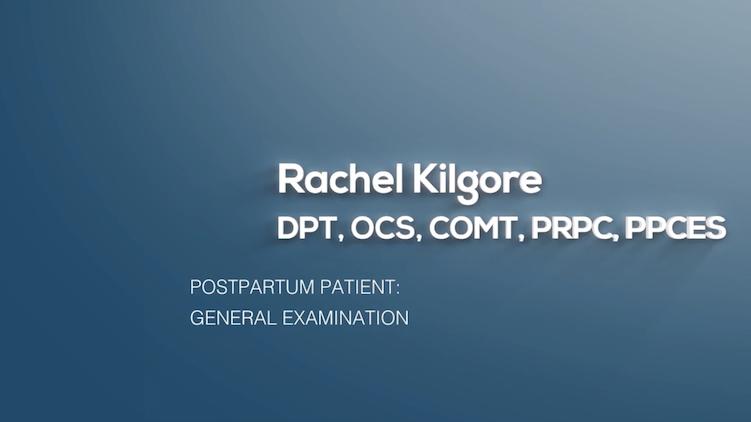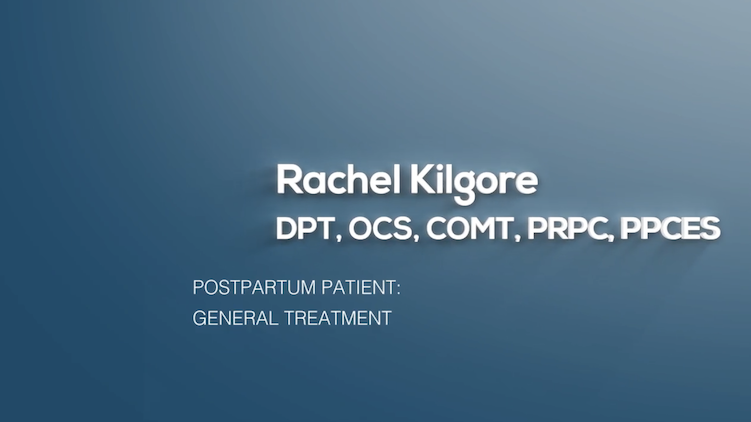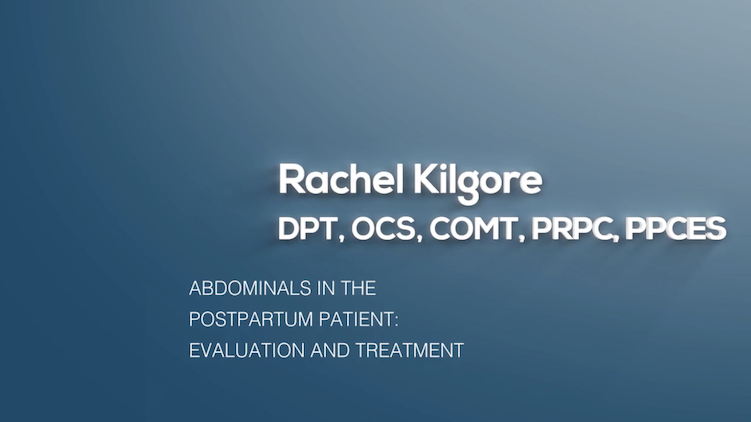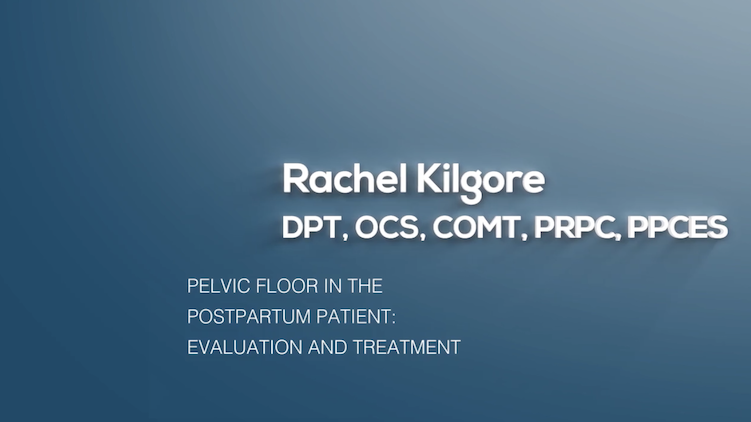
I have always enjoyed working with the peripartum population. However, the longer I worked in pelvic rehabilitation the more I heard the same story over and over when interviewing patients. For example, when working with a patient with urinary incontinence or prolapse, I would say: “when did this start” and some of my elderly patients would laugh and say “when Johnny was born” and I would say “how old is Johnny” they would reply “40!” Many of the pelvic patients I was treating had symptoms originating around the time of childbirth and they had been suffering for decades. So, I figured, let’s get to the root of the problem and focus on earlier intervention.

What is the root of the problem? In my opinion, it is the lack of postpartum care. Pregnant patients are often inundated with birth education programs and information about pregnancy and childbirth. Additionally, there is a battery of prenatal visits, prenatal testing, and preparations for birth. All of which are wonderful to help prepare for birth. Conversely, the resources and guidance to help with physiological and musculoskeletal healing postpartum are lacking. Patients are counseled about serious signs and symptoms, but clear guidance to help to return to daily functional activities including recreation and exercise is often not provided. As musculoskeletal and exercises experts we are in a wonderful position to help patients reduce pain and improve function following the birth of a child.
Prior to 2018, the first post-partum checkup was six weeks following birth. Barring any severe problems, this was often the last contact with a medical provider for the parent. Patients were not provided specific guidance on how to return to daily activities, let alone higher-level activities such as running, exercising, and/or lifting weights.
In 2018, the American College of Obstetrics and Gynecology (ACOG) revised its guidelines, which now support earlier and more frequent postpartum visits. It is recommended that the first contact between patient and obstetric care provider occur in the first three weeks following birth and that subsequent visits are scheduled as needed in an ongoing fashion1. This is important, as many consider the patient is still healing from birth up to 12 weeks (definitions vary). Depending on their knowledge and experience, a patient may not immediately realize they have a musculoskeletal problem. A new parent is busy adapting to their role as a care provider and may not be thinking about themselves. Additionally, they may not know what “normal” is for their body postpartum, including vaginal, abdominals, and/or bowel, and bladder functions. For example, the patient may be experiencing urinary incontinence (UI) which they “think” is normal postpartum, therefore, they may not bring it up to their provider. Patients often seek advice from family and friends who may even joke about peeing their pants when they sneeze or laugh or play with their children. Urinary incontinence is not ever “normal”, however, is it common in the postpartum period. Availability of vetted resources and a relationship with a healthcare provider are essential to cure these misconceptions.
According to a systematic review, the prevalence of urinary incontinence is 33% at three months postpartum2 and remains at 29% four years postpartum3. This means about one-third of women have urinary incontinence postpartum and remain that way without intervention. We also know the prevalence of urinary incontinence is strongly related to increasing age and underreported. This example highlights a common misconception: pelvic dysfunction is a normal part of the after-birth stage. However, with intervention, these problems can be alleviated, and we can improve the quality of life for these patients.
According to the American College of Physicians (ACP) clinical practice guidelines for non-surgical management of UI there is high-quality evidence that strongly recommends pelvic floor muscle training as the first-line treatment for stress incontinence.4
So why isn’t pelvic assessment and rehabilitation recommended for all people who birth in our country? In several European countries, pelvic rehab is standard postpartum care for anyone who births. Over the last two decades, I do see more postpartum patients referred for rehabilitation for their musculoskeletal impairments. However, I still think we need more skilled providers assisting these patients and spreading the word about the interventions rehabilitation professionals provide. These can range from common orthopedic complaints (e.g neck or back pain from repetitive baby care) to specific bladder and/or bowel dysfunction, such as leakage and/or constipation, abdominal separation (Diastasis Rectus Abdominus-DRA), prolapse, pelvic pain, perineal tearing, and/or pain with intercourse.
When developing this four-course postpartum series, I wanted rehabilitation providers to have more advanced skills to provide examination and treatment to this special population. This includes techniques to assess and treat the abdominals and pelvis, as these areas are physiologically impacted by pregnancy and birth over a relatively short amount of time. To effectively treat this population, one needs to be familiar with physiological changes from pregnancy, and stages of labor and birth to understand the journey of your patient. There is so much we can do to help these patients over a range of complaints, from acute breast and perineal care to DRA and pelvic dysfunctions. As with any special population, postpartum patients have unique red flags and concerns to monitor, and due to our more frequent patient contact, it is imperative to be proficient in screening for these conditions. These topics and more are included in the course series.
I am grateful and appreciative of this collaboration between Herman & Wallace and Medbridge to provide a platform for clinicians to progress their knowledge. Hopefully, this improves access to postpartum care and increases referrals for rehabilitation services to improve the function and quality of life for parents. Together we can reduce chronic impairments stemming from the childbirth period.
Resources:
- Accessed on 5/9/2022: https://www.acog.org/clinical/clinical-guidance/committee-opinion/articles/2018/05/optimizing-postpartum-care
- Thom, D. H., & Rortveit, G. (2010). Prevalence of postpartum urinary incontinence: a systematic review. Acta obstetricia et gynecologica Scandinavica, 89(12), 1511-1522.
- Gartland, D., MacArthur, C., Woolhouse, H., McDonald, E., & Brown, S. J. (2016). Frequency, severity and risk factors for urinary and faecal incontinence at 4 years postpartum: a prospective cohort. BJOG: An International Journal of Obstetrics & Gynaecology, 123(7), 1203-1211.
- Qaseem, A., Dallas, P., Forciea, M. A., Starkey, M., Denberg, T. D., Shekelle, P., & Clinical Guidelines Committee of the American College of Physicians*. (2014). Nonsurgical management of urinary incontinence in women: a clinical practice guideline from the American College of Physicians. Annals of internal medicine, 161(6), 429-440.
|
Postpartum Patient: General Examination Instructor: Rachel Kilgore, DPT, OCS, COMT, PRPC, PPCES
Postpartum Patient: General Treatment Instructor: Rachel Kilgore, DPT, OCS, COMT, PRPC, PPCES |
Abdominals in the Postpartum Patient: Evaluation and Treatment Instructor: Rachel Kilgore, DPT, OCS, COMT, PRPC, PPCES
Pelvic Floor in the Postpartum Patient: Evaluation and Treatment Instructor: Rachel Kilgore, DPT, OCS, COMT, PRPC, PPCES |









































